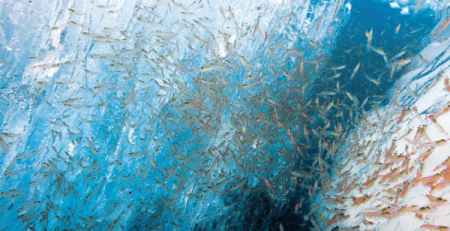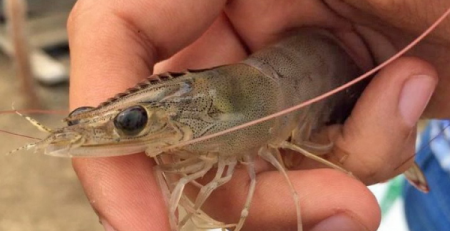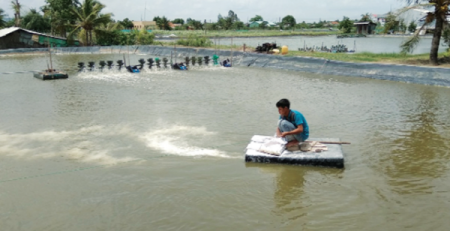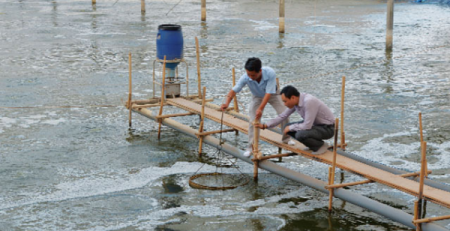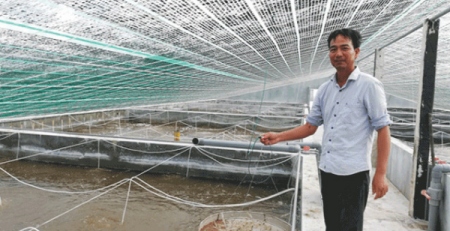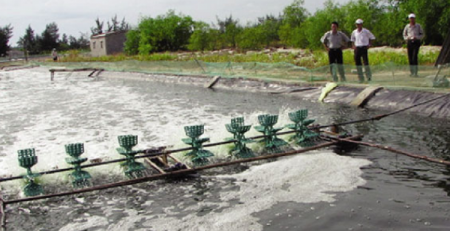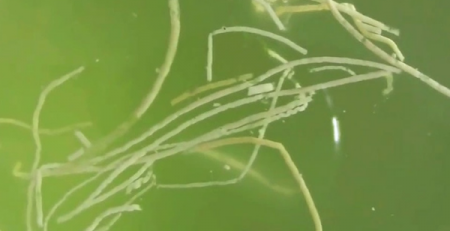Effective pond treatment before the crop
Nội dung bài viết [ẩn]
Pond improvement is a step to prepare suitable conditions for the next shrimp crop. This stage helps farmers actively handle problems occurring in the farming process, saving production costs and contributing to limiting disease on shrimps.

Clean the pond bottom after each crop Photo: DH
Pond drying, soil preparation, lime application
After each crop, ponds often accumulate clay particles eroded from soil and organic matter derived from dead plankton, uneaten feed, and shrimp manure. To clean the bottom of the pond, it is possible to use a hydraulic pump with a high pressure hose to suck or push the waste out of the pond when the pond bottom is wet or use the excavator after the bottom is dry.
Removal of sediment after each crop is necessary. Empty ponds are usually dried in the sun for two weeks or more. This step helps to reduce the moisture content of the soil to kill most organisms (including disease-causing organisms) left in the pond after drainage. Farmers can use plows or harrows to break up soil mass, increase soil contact with air and increase drying speed. However, it is not possible to dry the entire pond bottom, especially during the rainy season. Because some ponds have a rough surface with subsided land holding water for a long time while the rest of the bottom is dry. Or some ponds may not dry well due to the penetration of groundwater from nearby ponds or canals.
To overcome this situation, people used lime lime or hydrated lime applied to the pond bottom at high doses to increase soil pH enough to destroy unwanted organisms including disease-causing organisms. The high effective dosage is 3,000 kg / ha (300 g / m2) of lime or 4,000 kg / ha (400 g / m2) hydrated lime. The best possible procedure is to dry the pond bottom and lime treatment for non-dry bottom areas. Calcium hypochlorite Ca (ClO) 2 – Chlorine disinfectant, is a mixture of lime and Calcium chloride applied on wet areas for disinfection purposes, the dosage is about 100-200 g / m2. Copper sulfate, Formalin and Potassium permanganate (potassium permanganate) have also been used, but the effect is not high
Water supply, sterilization
Feed water enters the pond through a filter bag or sieve to remove unwanted organisms. Although the filtration process will reduce the possibility of fish and other large organisms entering the pond, it will not prevent the entry of many pathogenic organisms. Therefore, the most effective way is to provide water to sterilize. Disinfectants are applied to water in settling ponds or carried out directly in ponds. A variety of disinfectants such as Calcium hypochlorite, Chloramine T, Potassium permanganate, Copper sulfate, Hydro peroxide, iodine compounds, Benzalkonium chloride and Glutaraldehyd are used. However, the most effective is probably Calcium hydochlorite at a concentration of 20-30 mg / L.
Causing color and stocking
Postlarval shrimp can use commercial feed, but they benefit greatly from natural organisms for a few weeks after stocking. Ponds should be colored to encourage the growth of phytoplankton, zooplankton and benthos before stocking. Use urea and superphosphate or other commercial fertilizers to promote the growth of phytoplankton.
However, the use of a combination of organic fertilizers and commercial fertilizers will lead to a rapid increase in zooplankton and benthic organisms rather than just using commercial fertilizers. And a better way is to apply soy flour, shrimp feed, rice bran or some other high quality organic matter. The typical rate is 6 to 8 kg of nitrogen (12-18 kg of urea / ha), 1 to 2 kg of phosphorus (5 to 10 kg of superphosphate / ha) and about 100 – 200 kg of organic fertilizer / ha of high quality . It is necessary to repeat several times until the pond appears beautiful water color. The coloration may have to be continued over a period of two to three weeks to maintain plankton blooms, but once the feeding rate reaches 20 to 30 kg / ha / day, there is no need to color by have enough nutrients due to leftovers, feces and shrimp excretion.
Source: contom.vn


